Linshan Jiang
Hypernetworks for Model-Heterogeneous Personalized Federated Learning
Jul 30, 2025Abstract:Recent advances in personalized federated learning have focused on addressing client model heterogeneity. However, most existing methods still require external data, rely on model decoupling, or adopt partial learning strategies, which can limit their practicality and scalability. In this paper, we revisit hypernetwork-based methods and leverage their strong generalization capabilities to design a simple yet effective framework for heterogeneous personalized federated learning. Specifically, we propose MH-pFedHN, which leverages a server-side hypernetwork that takes client-specific embedding vectors as input and outputs personalized parameters tailored to each client's heterogeneous model. To promote knowledge sharing and reduce computation, we introduce a multi-head structure within the hypernetwork, allowing clients with similar model sizes to share heads. Furthermore, we further propose MH-pFedHNGD, which integrates an optional lightweight global model to improve generalization. Our framework does not rely on external datasets and does not require disclosure of client model architectures, thereby offering enhanced privacy and flexibility. Extensive experiments on multiple benchmarks and model settings demonstrate that our approach achieves competitive accuracy, strong generalization, and serves as a robust baseline for future research in model-heterogeneous personalized federated learning.
Edge Intelligence with Spiking Neural Networks
Jul 18, 2025Abstract:The convergence of artificial intelligence and edge computing has spurred growing interest in enabling intelligent services directly on resource-constrained devices. While traditional deep learning models require significant computational resources and centralized data management, the resulting latency, bandwidth consumption, and privacy concerns have exposed critical limitations in cloud-centric paradigms. Brain-inspired computing, particularly Spiking Neural Networks (SNNs), offers a promising alternative by emulating biological neuronal dynamics to achieve low-power, event-driven computation. This survey provides a comprehensive overview of Edge Intelligence based on SNNs (EdgeSNNs), examining their potential to address the challenges of on-device learning, inference, and security in edge scenarios. We present a systematic taxonomy of EdgeSNN foundations, encompassing neuron models, learning algorithms, and supporting hardware platforms. Three representative practical considerations of EdgeSNN are discussed in depth: on-device inference using lightweight SNN models, resource-aware training and updating under non-stationary data conditions, and secure and privacy-preserving issues. Furthermore, we highlight the limitations of evaluating EdgeSNNs on conventional hardware and introduce a dual-track benchmarking strategy to support fair comparisons and hardware-aware optimization. Through this study, we aim to bridge the gap between brain-inspired learning and practical edge deployment, offering insights into current advancements, open challenges, and future research directions. To the best of our knowledge, this is the first dedicated and comprehensive survey on EdgeSNNs, providing an essential reference for researchers and practitioners working at the intersection of neuromorphic computing and edge intelligence.
Automatic Pruning via Structured Lasso with Class-wise Information
Feb 13, 2025Abstract:Most pruning methods concentrate on unimportant filters of neural networks. However, they face the loss of statistical information due to a lack of consideration for class-wise data. In this paper, from the perspective of leveraging precise class-wise information for model pruning, we utilize structured lasso with guidance from Information Bottleneck theory. Our approach ensures that statistical information is retained during the pruning process. With these techniques, we introduce two innovative adaptive network pruning schemes: sparse graph-structured lasso pruning with Information Bottleneck (\textbf{sGLP-IB}) and sparse tree-guided lasso pruning with Information Bottleneck (\textbf{sTLP-IB}). The key aspect is pruning model filters using sGLP-IB and sTLP-IB to better capture class-wise relatedness. Compared to multiple state-of-the-art methods, our approaches demonstrate superior performance across three datasets and six model architectures in extensive experiments. For instance, using the VGG16 model on the CIFAR-10 dataset, we achieve a parameter reduction of 85%, a decrease in FLOPs by 61%, and maintain an accuracy of 94.10% (0.14% higher than the original model); we reduce the parameters by 55% with the accuracy at 76.12% using the ResNet architecture on ImageNet (only drops 0.03%). In summary, we successfully reduce model size and computational resource usage while maintaining accuracy. Our codes are at https://anonymous.4open.science/r/IJCAI-8104.
One-shot Federated Learning Methods: A Practical Guide
Feb 13, 2025Abstract:One-shot Federated Learning (OFL) is a distributed machine learning paradigm that constrains client-server communication to a single round, addressing privacy and communication overhead issues associated with multiple rounds of data exchange in traditional Federated Learning (FL). OFL demonstrates the practical potential for integration with future approaches that require collaborative training models, such as large language models (LLMs). However, current OFL methods face two major challenges: data heterogeneity and model heterogeneity, which result in subpar performance compared to conventional FL methods. Worse still, despite numerous studies addressing these limitations, a comprehensive summary is still lacking. To address these gaps, this paper presents a systematic analysis of the challenges faced by OFL and thoroughly reviews the current methods. We also offer an innovative categorization method and analyze the trade-offs of various techniques. Additionally, we discuss the most promising future directions and the technologies that should be integrated into the OFL field. This work aims to provide guidance and insights for future research.
FedLEC: Effective Federated Learning Algorithm with Spiking Neural Networks Under Label Skews
Dec 23, 2024Abstract:With the advancement of neuromorphic chips, implementing Federated Learning (FL) with Spiking Neural Networks (SNNs) potentially offers a more energy-efficient schema for collaborative learning across various resource-constrained edge devices. However, one significant challenge in the FL systems is that the data from different clients are often non-independently and identically distributed (non-IID), with label skews presenting substantial difficulties in various federated SNN learning tasks. In this study, we propose a practical post-hoc framework named FedLEC to address the challenge. This framework penalizes the corresponding local logits for locally missing labels to enhance each local model's generalization ability. Additionally, it leverages the pertinent label distribution information distilled from the global model to mitigate label bias. Extensive experiments with three different structured SNNs across five datasets (i.e., three non-neuromorphic and two neuromorphic datasets) demonstrate the efficiency of FedLEC. Compared to seven state-of-the-art FL algorithms, FedLEC achieves an average accuracy improvement of approximately 11.59\% under various label skew distribution settings.
"They've Stolen My GPL-Licensed Model!": Toward Standardized and Transparent Model Licensing
Dec 16, 2024



Abstract:As model parameter sizes reach the billion-level range and their training consumes zettaFLOPs of computation, components reuse and collaborative development are become increasingly prevalent in the Machine Learning (ML) community. These components, including models, software, and datasets, may originate from various sources and be published under different licenses, which govern the use and distribution of licensed works and their derivatives. However, commonly chosen licenses, such as GPL and Apache, are software-specific and are not clearly defined or bounded in the context of model publishing. Meanwhile, the reused components may also have free-content licenses and model licenses, which pose a potential risk of license noncompliance and rights infringement within the model production workflow. In this paper, we propose addressing the above challenges along two lines: 1) For license analysis, we have developed a new vocabulary for ML workflow management and encoded license rules to enable ontological reasoning for analyzing rights granting and compliance issues. 2) For standardized model publishing, we have drafted a set of model licenses that provide flexible options to meet the diverse needs of model publishing. Our analysis tool is built on Turtle language and Notation3 reasoning engine, envisioned as a first step toward Linked Open Model Production Data. We have also encoded our proposed model licenses into rules and demonstrated the effects of GPL and other commonly used licenses in model publishing, along with the flexibility advantages of our licenses, through comparisons and experiments.
ED-ViT: Splitting Vision Transformer for Distributed Inference on Edge Devices
Oct 15, 2024

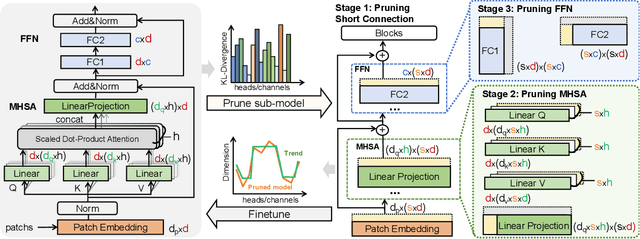

Abstract:Deep learning models are increasingly deployed on resource-constrained edge devices for real-time data analytics. In recent years, Vision Transformer models and their variants have demonstrated outstanding performance across various computer vision tasks. However, their high computational demands and inference latency pose significant challenges for model deployment on resource-constraint edge devices. To address this issue, we propose a novel Vision Transformer splitting framework, ED-ViT, designed to execute complex models across multiple edge devices efficiently. Specifically, we partition Vision Transformer models into several sub-models, where each sub-model is tailored to handle a specific subset of data classes. To further minimize computation overhead and inference latency, we introduce a class-wise pruning technique that reduces the size of each sub-model. We conduct extensive experiments on five datasets with three model structures, demonstrating that our approach significantly reduces inference latency on edge devices and achieves a model size reduction of up to 28.9 times and 34.1 times, respectively, while maintaining test accuracy comparable to the original Vision Transformer. Additionally, we compare ED-ViT with two state-of-the-art methods that deploy CNN and SNN models on edge devices, evaluating accuracy, inference time, and overall model size. Our comprehensive evaluation underscores the effectiveness of the proposed ED-ViT framework.
FedLPA: Personalized One-shot Federated Learning with Layer-Wise Posterior Aggregation
Oct 03, 2023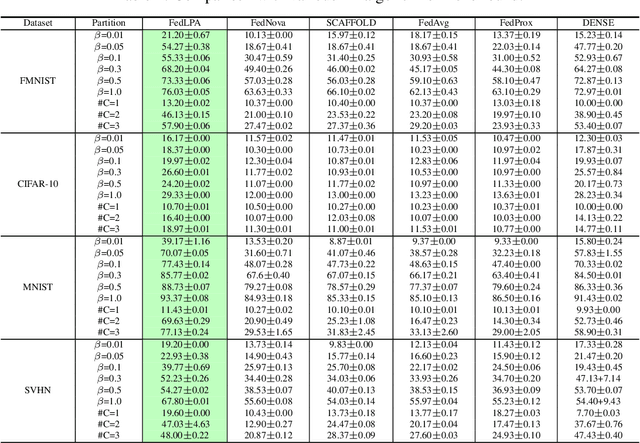
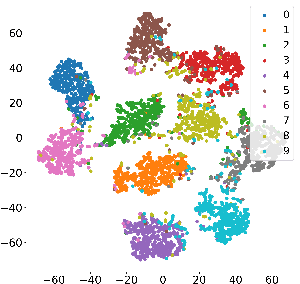
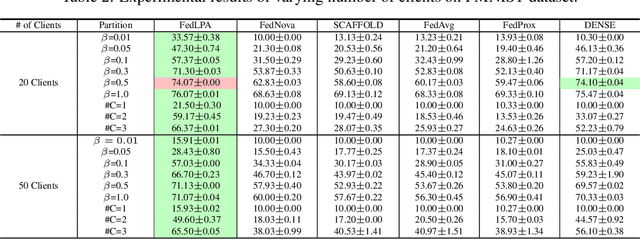
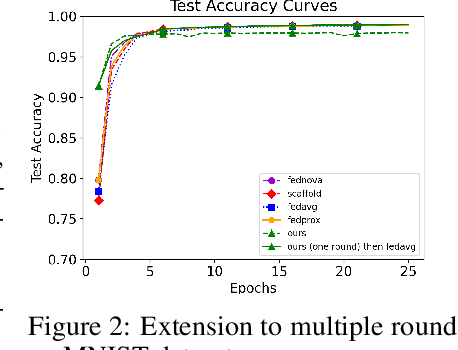
Abstract:Efficiently aggregating trained neural networks from local clients into a global model on a server is a widely researched topic in federated learning. Recently, motivated by diminishing privacy concerns, mitigating potential attacks, and reducing the overhead of communication, one-shot federated learning (i.e., limiting client-server communication into a single round) has gained popularity among researchers. However, the one-shot aggregation performances are sensitively affected by the non-identical training data distribution, which exhibits high statistical heterogeneity in some real-world scenarios. To address this issue, we propose a novel one-shot aggregation method with Layer-wise Posterior Aggregation, named FedLPA. FedLPA aggregates local models to obtain a more accurate global model without requiring extra auxiliary datasets or exposing any confidential local information, e.g., label distributions. To effectively capture the statistics maintained in the biased local datasets in the practical non-IID scenario, we efficiently infer the posteriors of each layer in each local model using layer-wise Laplace approximation and aggregate them to train the global parameters. Extensive experimental results demonstrate that FedLPA significantly improves learning performance over state-of-the-art methods across several metrics.
PriMask: Cascadable and Collusion-Resilient Data Masking for Mobile Cloud Inference
Nov 12, 2022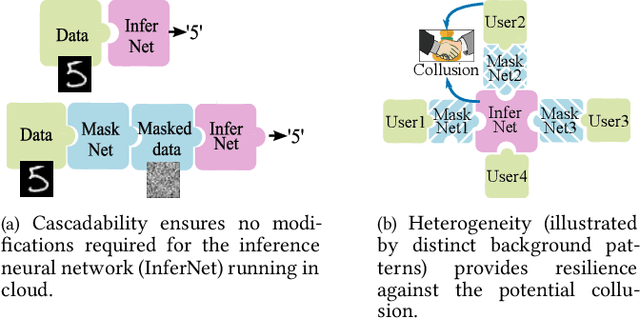
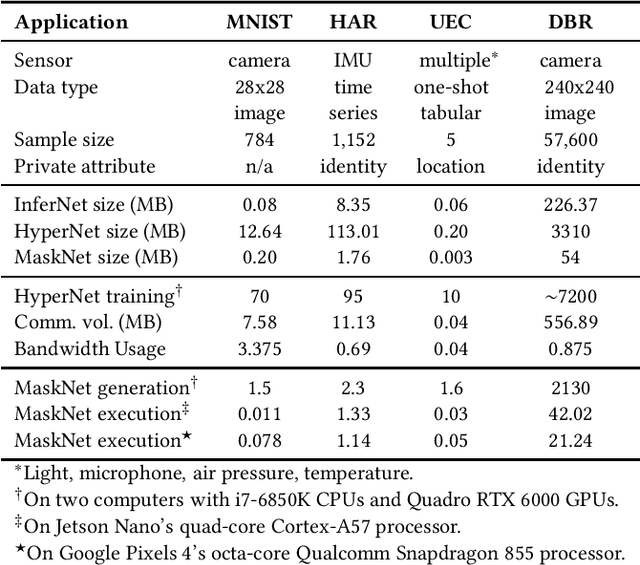
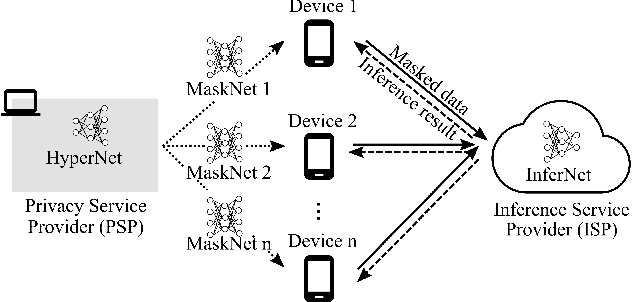

Abstract:Mobile cloud offloading is indispensable for inference tasks based on large-scale deep models. However, transmitting privacy-rich inference data to the cloud incurs concerns. This paper presents the design of a system called PriMask, in which the mobile device uses a secret small-scale neural network called MaskNet to mask the data before transmission. PriMask significantly weakens the cloud's capability to recover the data or extract certain private attributes. The MaskNet is em cascadable in that the mobile can opt in to or out of its use seamlessly without any modifications to the cloud's inference service. Moreover, the mobiles use different MaskNets, such that the collusion between the cloud and some mobiles does not weaken the protection for other mobiles. We devise a {\em split adversarial learning} method to train a neural network that generates a new MaskNet quickly (within two seconds) at run time. We apply PriMask to three mobile sensing applications with diverse modalities and complexities, i.e., human activity recognition, urban environment crowdsensing, and driver behavior recognition. Results show PriMask's effectiveness in all three applications.
On Lightweight Privacy-Preserving Collaborative Learning for Internet of Things by Independent Random Projections
Dec 11, 2020



Abstract:The Internet of Things (IoT) will be a main data generation infrastructure for achieving better system intelligence. This paper considers the design and implementation of a practical privacy-preserving collaborative learning scheme, in which a curious learning coordinator trains a better machine learning model based on the data samples contributed by a number of IoT objects, while the confidentiality of the raw forms of the training data is protected against the coordinator. Existing distributed machine learning and data encryption approaches incur significant computation and communication overhead, rendering them ill-suited for resource-constrained IoT objects. We study an approach that applies independent random projection at each IoT object to obfuscate data and trains a deep neural network at the coordinator based on the projected data from the IoT objects. This approach introduces light computation overhead to the IoT objects and moves most workload to the coordinator that can have sufficient computing resources. Although the independent projections performed by the IoT objects address the potential collusion between the curious coordinator and some compromised IoT objects, they significantly increase the complexity of the projected data. In this paper, we leverage the superior learning capability of deep learning in capturing sophisticated patterns to maintain good learning performance. The extensive comparative evaluation shows that this approach outperforms other lightweight approaches that apply additive noisification for differential privacy and/or support vector machines for learning in the applications with light to moderate data pattern complexities.
 Add to Chrome
Add to Chrome Add to Firefox
Add to Firefox Add to Edge
Add to Edge